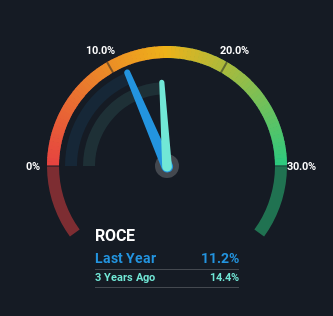- Singapore
- /
- Marine and Shipping
- /
- SGX:D8DU
Returns On Capital Are Showing Encouraging Signs At First Ship Lease Trust (SGX:D8DU)

There are a few key trends to look for if we want to identify the next multi-bagger. Firstly, we'd want to identify a growing return on capital employed (ROCE) and then alongside that, an ever-increasing base of capital employed. This shows us that it's a compounding machine, able to continually reinvest its earnings back into the business and generate higher returns. Speaking of which, we noticed some great changes in First Ship Lease Trust's (SGX:D8DU) returns on capital, so let's have a look.
Return On Capital Employed (ROCE): What Is It?
If you haven't worked with ROCE before, it measures the 'return' (pre-tax profit) a company generates from capital employed in its business. The formula for this calculation on First Ship Lease Trust is:
Return on Capital Employed = Earnings Before Interest and Tax (EBIT) ÷ (Total Assets - Current Liabilities)
0.11 = US$6.8m ÷ (US$66m - US$4.2m) (Based on the trailing twelve months to June 2023).
So, First Ship Lease Trust has an ROCE of 11%. On its own, that's a standard return, however it's much better than the 8.2% generated by the Shipping industry.
Check out our latest analysis for First Ship Lease Trust

Historical performance is a great place to start when researching a stock so above you can see the gauge for First Ship Lease Trust's ROCE against it's prior returns. If you're interested in investigating First Ship Lease Trust's past further, check out this free graph of past earnings, revenue and cash flow.
How Are Returns Trending?
You'd find it hard not to be impressed with the ROCE trend at First Ship Lease Trust. We found that the returns on capital employed over the last five years have risen by 115%. That's a very favorable trend because this means that the company is earning more per dollar of capital that's being employed. Interestingly, the business may be becoming more efficient because it's applying 69% less capital than it was five years ago. A business that's shrinking its asset base like this isn't usually typical of a soon to be multi-bagger company.
In another part of our analysis, we noticed that the company's ratio of current liabilities to total assets decreased to 6.5%, which broadly means the business is relying less on its suppliers or short-term creditors to fund its operations. So shareholders would be pleased that the growth in returns has mostly come from underlying business performance.
In Conclusion...
In a nutshell, we're pleased to see that First Ship Lease Trust has been able to generate higher returns from less capital. And a remarkable 326% total return over the last five years tells us that investors are expecting more good things to come in the future. In light of that, we think it's worth looking further into this stock because if First Ship Lease Trust can keep these trends up, it could have a bright future ahead.
First Ship Lease Trust does have some risks though, and we've spotted 2 warning signs for First Ship Lease Trust that you might be interested in.
While First Ship Lease Trust may not currently earn the highest returns, we've compiled a list of companies that currently earn more than 25% return on equity. Check out this free list here.
New: AI Stock Screener & Alerts
Our new AI Stock Screener scans the market every day to uncover opportunities.
• Dividend Powerhouses (3%+ Yield)
• Undervalued Small Caps with Insider Buying
• High growth Tech and AI Companies
Or build your own from over 50 metrics.
Have feedback on this article? Concerned about the content? Get in touch with us directly. Alternatively, email editorial-team (at) simplywallst.com.
This article by Simply Wall St is general in nature. We provide commentary based on historical data and analyst forecasts only using an unbiased methodology and our articles are not intended to be financial advice. It does not constitute a recommendation to buy or sell any stock, and does not take account of your objectives, or your financial situation. We aim to bring you long-term focused analysis driven by fundamental data. Note that our analysis may not factor in the latest price-sensitive company announcements or qualitative material. Simply Wall St has no position in any stocks mentioned.
About SGX:D8DU
First Ship Lease Trust
A business trust, owns a fleet of product tankers in Europe.
Flawless balance sheet with solid track record.
Market Insights
Community Narratives




